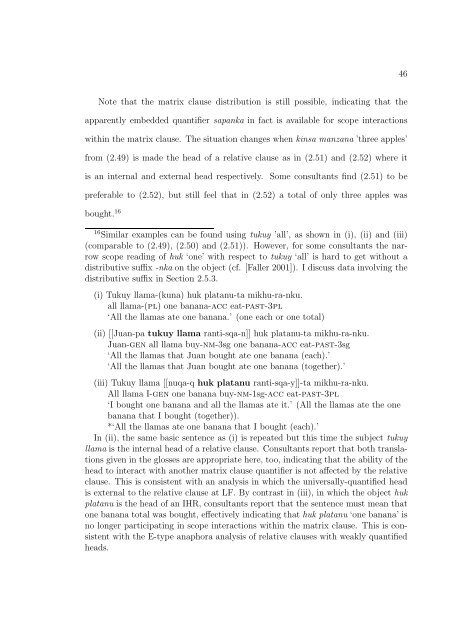the syntax and semantics of relativization and quantification
the syntax and semantics of relativization and quantification
the syntax and semantics of relativization and quantification
You also want an ePaper? Increase the reach of your titles
YUMPU automatically turns print PDFs into web optimized ePapers that Google loves.
46<br />
Note that <strong>the</strong> matrix clause distribution is still possible, indicating that <strong>the</strong><br />
apparently embedded quantifier sapanka in fact is available for scope interactions<br />
within <strong>the</strong> matrix clause. The situation changes when kinsa manzana ’three apples’<br />
from (2.49) is made <strong>the</strong> head <strong>of</strong> a relative clause as in (2.51) <strong>and</strong> (2.52) where it<br />
is an internal <strong>and</strong> external head respectively. Some consultants find (2.51) to be<br />
preferable to (2.52), but still feel that in (2.52) a total <strong>of</strong> only three apples was<br />
bought. 16<br />
16 Similar examples can be found using tukuy ’all’, as shown in (i), (ii) <strong>and</strong> (iii)<br />
(comparable to (2.49), (2.50) <strong>and</strong> (2.51)). However, for some consultants <strong>the</strong> narrow<br />
scope reading <strong>of</strong> huk ‘one’ with respect to tukuy ‘all’ is hard to get without a<br />
distributive suffix -nka on <strong>the</strong> object (cf. [Faller 2001]). I discuss data involving <strong>the</strong><br />
distributive suffix in Section 2.5.3.<br />
(i) Tukuy llama-(kuna) huk platanu-ta mikhu-ra-nku.<br />
all llama-(pl) one banana-acc eat-past-3pl<br />
‘All <strong>the</strong> llamas ate one banana.’ (one each or one total)<br />
(ii) [[Juan-pa tukuy llama ranti-sqa-n]] huk platanu-ta mikhu-ra-nku.<br />
Juan-gen all llama buy-nm-3sg one banana-acc eat-past-3sg<br />
‘All <strong>the</strong> llamas that Juan bought ate one banana (each).’<br />
‘All <strong>the</strong> llamas that Juan bought ate one banana (toge<strong>the</strong>r).’<br />
(iii) Tukuy llama [[nuqa-q huk platanu ranti-sqa-y]]-ta mikhu-ra-nku.<br />
All llama I-gen one banana buy-nm-1sg-acc eat-past-3pl<br />
‘I bought one banana <strong>and</strong> all <strong>the</strong> llamas ate it.’ (All <strong>the</strong> llamas ate <strong>the</strong> one<br />
banana that I bought (toge<strong>the</strong>r)).<br />
*‘All <strong>the</strong> llamas ate one banana that I bought (each).’<br />
In (ii), <strong>the</strong> same basic sentence as (i) is repeated but this time <strong>the</strong> subject tukuy<br />
llama is <strong>the</strong> internal head <strong>of</strong> a relative clause. Consultants report that both translations<br />
given in <strong>the</strong> glosses are appropriate here, too, indicating that <strong>the</strong> ability <strong>of</strong> <strong>the</strong><br />
head to interact with ano<strong>the</strong>r matrix clause quantifier is not affected by <strong>the</strong> relative<br />
clause. This is consistent with an analysis in which <strong>the</strong> universally-quantified head<br />
is external to <strong>the</strong> relative clause at LF. By contrast in (iii), in which <strong>the</strong> object huk<br />
platanu is <strong>the</strong> head <strong>of</strong> an IHR, consultants report that <strong>the</strong> sentence must mean that<br />
one banana total was bought, effectively indicating that huk platanu ‘one banana’ is<br />
no longer participating in scope interactions within <strong>the</strong> matrix clause. This is consistent<br />
with <strong>the</strong> E-type anaphora analysis <strong>of</strong> relative clauses with weakly quantified<br />
heads.
















